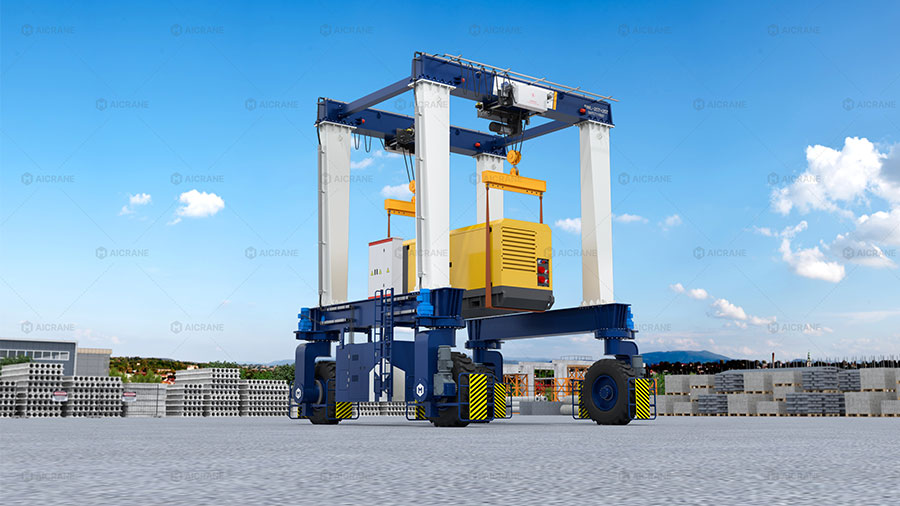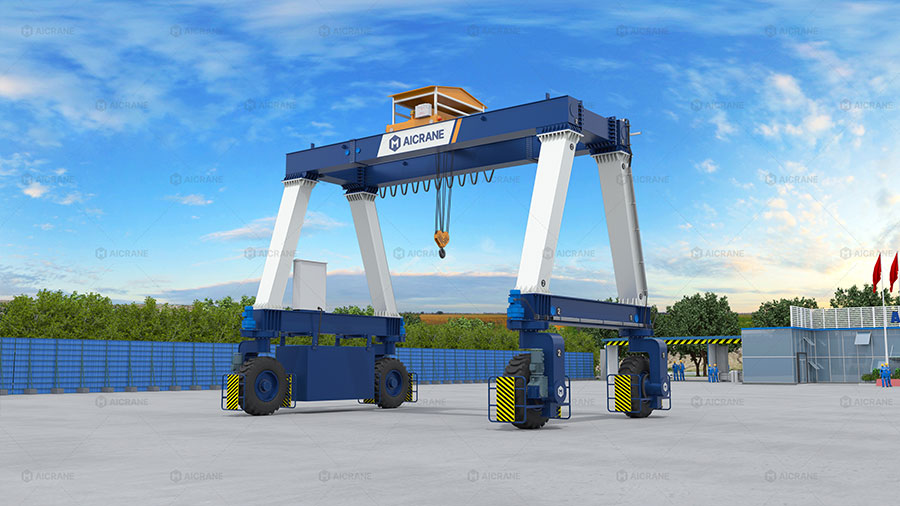Rubber Tired Gantry (RTG) cranes are indispensable in modern container terminals and industrial yards due to their mobility, operational flexibility, and ability to handle heavy loads with precision. These cranes operate on rubber tires rather than fixed rails, enabling them to move across yards freely and access containers or cargo without the constraints of a rail system. One of the fundamental design aspects that significantly influences the operational reliability and safety of RTG cranes is structural symmetry. Structural symmetry in RTG cranes plays a pivotal role in maintaining stability, load balance, and consistent performance under dynamic conditions. This article explores why structural symmetry is critical in RTG crane design and how it contributes to long-term operational success.

What is Structural Symmetry in RTG Cranes?
Structural symmetry refers to a balanced and mirrored configuration of the crane’s physical structure around its central vertical and horizontal axes. In a rubber tired gantry crane, this includes the symmetrical arrangement of legs, girders, cross beams, wheels, hoist mechanisms, and the trolley.
An ideal symmetrical structure means the left and right sides, as well as the front and rear, are nearly identical in weight distribution, shape, and structural resistance. This uniformity is not merely an aesthetic feature—it is integral to the crane’s engineering and functional safety.
Key Components Requiring Symmetrical Design
1. Main Girder and Cross Beam Configuration
The main girder, which spans the width of the RTG crane, must be evenly supported by the legs on either side. A symmetrical beam ensures even load transmission and reduces the risk of torsional stresses when lifting heavy loads.
2. Leg and Wheel Alignment
The gantry legs and the rubber-tired wheel assemblies should be mirrored on both sides. This ensures that the crane maintains even ground contact pressure and uniform traction, especially on uneven or inclined surfaces.
3. Hoist Trolley and Spreader Positioning
The hoist trolley, which moves along the main girder, must operate in a symmetrically centered position relative to the crane’s width. This prevents asymmetric loading conditions that could lead to tipping or uneven wear on structural components.
The Role of Symmetry in Load Stability
1. Preventing Tipping and Overturning
Structural symmetry helps keep the crane’s center of gravity centered between the rubber-tired wheels. During lifting operations, if the crane lacks symmetry, uneven weight distribution can cause one side to become overloaded, significantly increasing the risk of tipping. This is especially dangerous when the crane is moving with a suspended load or when subjected to lateral wind forces.
2. Equal Load Distribution on Tires
RTG cranes have multiple wheels—often eight or more—distributed along two sides. Symmetry ensures that the vertical load is evenly distributed across all wheels. Uneven load on tires not only affects traction and braking but also leads to premature wear, increased maintenance costs, and decreased crane stability during movement.
3. Smooth and Stable Travel
When the crane structure is balanced symmetrically, it can move smoothly across the yard without lateral swaying or vibration. This improves safety and precision during container positioning and enhances operator confidence, especially when handling high-value or hazardous loads.

Structural Symmetry and Wind Resistance
One often-overlooked factor in RTG wheeled gantry crane design is wind resistance. RTG cranes, due to their large surface area and height, are susceptible to lateral wind loads. Symmetrical structures resist wind-induced torsion more effectively than asymmetrical ones. The even distribution of mass and geometry enables the crane to absorb wind energy more uniformly, reducing the risk of structural deflection or collapse during high winds.
Moreover, during typhoon or storm conditions, symmetrical cranes are easier to secure with tie-downs or storm brakes, as their structural behavior under stress is predictable and balanced.
Dynamic Load Effects and Symmetry
RTG cranes are frequently subjected to dynamic forces resulting from acceleration, deceleration, braking, and sudden load swings. Symmetrical design ensures that these dynamic forces are absorbed evenly throughout the crane structure, preventing local stress concentrations that could lead to fatigue or cracking.
For example, when the trolley changes direction abruptly, a symmetrical frame will distribute the resulting inertia forces uniformly across the gantry. Asymmetric structures, on the other hand, may twist or deform unevenly, which can compromise structural integrity over time.
Impact on Maintenance and Service Life
1. Reduced Wear and Tear
A balanced structure reduces uneven stresses on components like tires, gears, hoists, and bearings. This minimizes wear and reduces the frequency of component replacement or alignment correction, extending the crane’s operational life.
2. Simplified Inspections
When structural components are symmetrical, maintenance inspections and diagnostics are easier to perform. Technicians can compare the condition of left and right sections directly, making it easier to identify anomalies or potential faults.
3. Better Predictive Maintenance
Digital twin technology and load monitoring systems often rely on symmetrical assumptions in their predictive models. If the structure is asymmetric, these predictions become less reliable. Thus, maintaining symmetry is also crucial for adopting smart crane technologies.
Structural Symmetry in Custom Designs
While standard RTG cranes are designed with inherent symmetry, custom mobile gantry crane for sale may sometimes require modifications based on site constraints or specific applications. In such cases, it becomes vital to preserve functional symmetry even if the physical geometry is altered.
For instance, if a crane must have a longer cantilever on one side for extended reach, counterbalances or reinforced structural elements must be added to maintain equilibrium. Finite Element Analysis (FEA) is often employed in such scenarios to model load responses and ensure that structural symmetry in terms of mass and stiffness is preserved.
Operator Comfort and Safety
Symmetry in RTG cranes also contributes to operator comfort. A balanced crane exhibits less sway and vibration, leading to a more stable operating platform for cab-mounted or remote-controlled systems. This minimizes operator fatigue, improves concentration, and reduces the likelihood of accidents.
Furthermore, during emergency braking or power failure, a symmetrically designed RTG is less likely to experience differential rolling or skewing, which could otherwise lead to unsafe conditions or equipment damage.
Conclusion
In conclusion, structural symmetry is not just a design preference—it is a necessity for ensuring the safe, reliable, and efficient operation of rubber tired gantry cranes. From preventing tipping and enabling stable movement, to improving wind resistance and extending service life, symmetry underpins nearly every performance metric of an RTG crane.
As gantry crane manufacturers push for higher lifting capacities and greater automation, ensuring structural symmetry becomes even more critical. Investing in symmetric structural design not only enhances crane safety and performance but also yields long-term operational savings through reduced maintenance, improved reliability, and higher user satisfaction.
For users and procurement professionals, understanding the importance of symmetry can also guide better decision-making when evaluating custom RTG solutions or selecting cranes for specific terminal layouts. Ultimately, a well-balanced crane is a stable crane—and stability is the foundation of productivity in heavy-duty lifting environments.